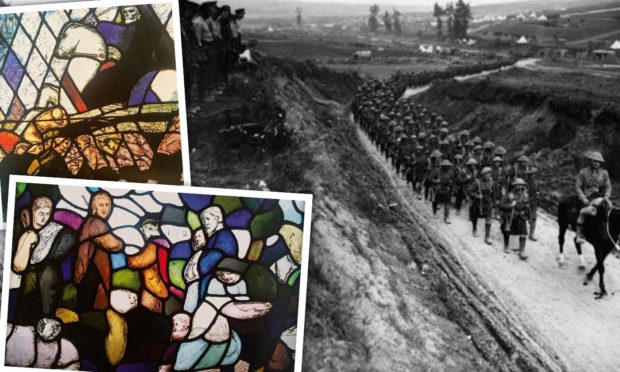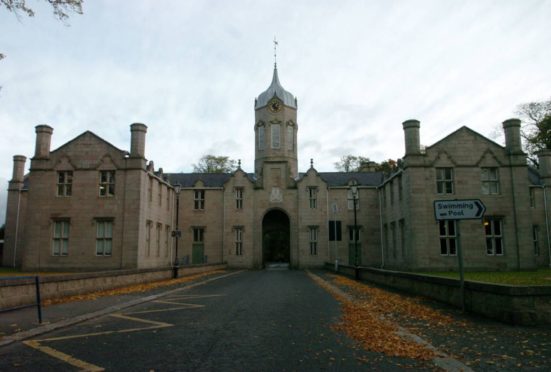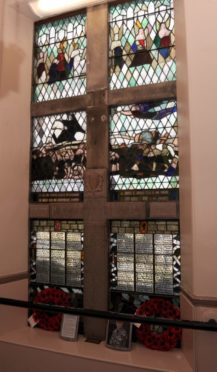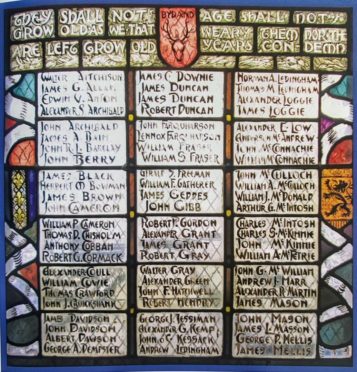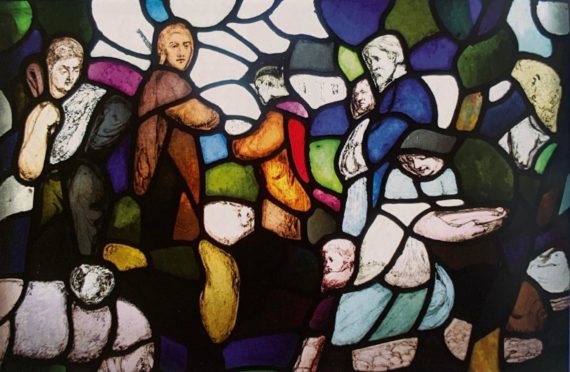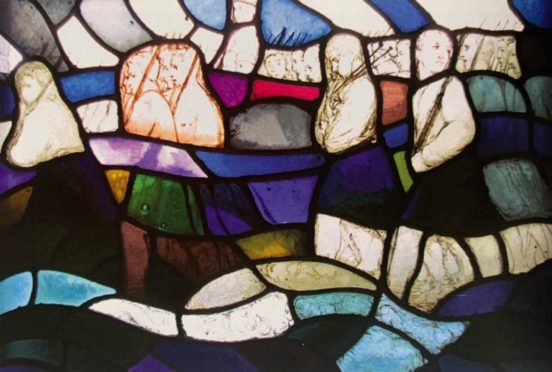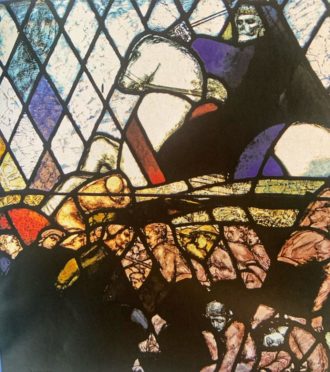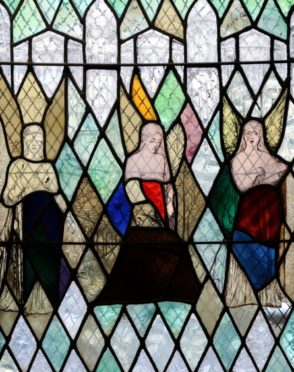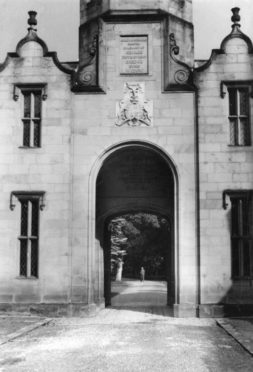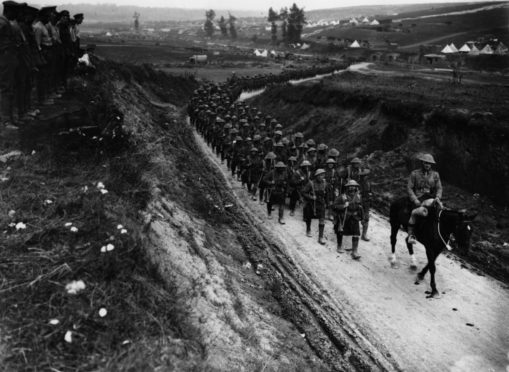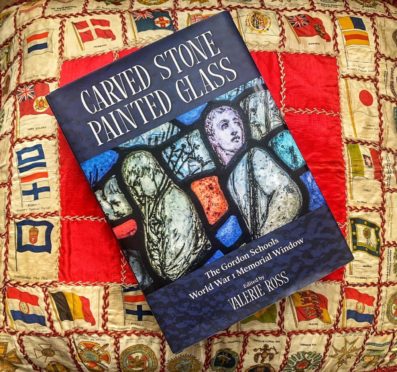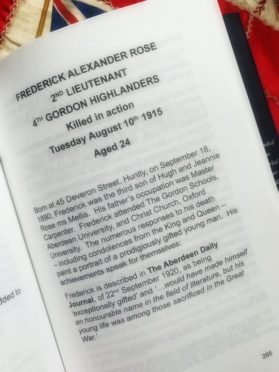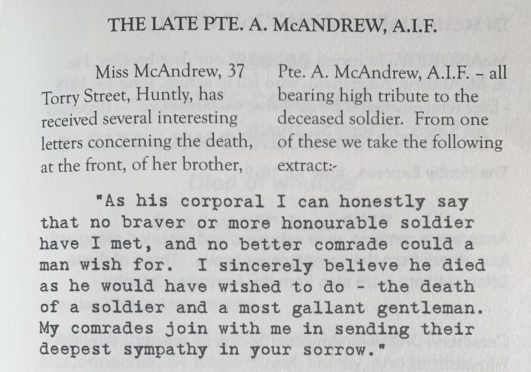When the poignant war memorial window at The Gordon Schools in Huntly was unveiled 100 years ago today, it was said the school and Castle Park “helped to win the great war”.
Of the 700 men who left the small, rural parish of Huntly to fight in the First World War, 144 of those who never returned were teachers and former pupils of The Gordon Schools.
The loss was keenly felt in the close-knit community, particularly at the secondary school.
A fitting tribute
The Gordon Schools’ rector David James could never have imagined the generation of young scholars he watched on the playing fields of the Castle Park would end up dead on the battlefields of Europe.
A kindly man, whom one colleague said “to know him was to love him”, Mr James knew each individual who fell personally.
From his fellow teachers, to the town architect’s sons, to the lads who laboured on farms, each lost life resonated deeply with him.
Mr James commissioned his artist friend James Hector to create a touching and lasting tribute to their memory at the school.
The Aberdeen artist hand-painted stained glass panels to form a memorial window, standing several feet tall in the main stairwell, bearing the name of each lost man.
In addition to commissioning the window, Mr James penned a tribute to the fallen – ‘By the storied walls of the Gordon’s hold’, which became the school song.
The music was composed by the school’s music master Mr T Wright and the lyrics referenced the lives lost in the First World War:
Oh proud is the fame of the Gordon’s name
on many a hill you shall find their graves
And theres’ many a lad by the tower who played
Has passed in the splendor that crowns the brave!
For freedom! For honour! Our loves resigned
Let us harken the message they leave behind.
The memorial window
The artist created the memorial window from six panels made up of individual pieces of glass “stained lightly all over to keep the necessary sobriety of effect”.
The stained glass cleverly depicts a tableau of war: from the outbreak to the home front, the frontline to victory.
At the bottom, two panels are painstakingly inscribed with the 144 names, and underneath are detailed pieces of glass with delicate depictions of rural peacetime.
It was explained at the time: “On the right a scene from rural life, representing typical occupations of peace: farmer, hunter, shepherd including the student as representing them all.
“Here the effect is broken up with patches of light and shadow and bright colour, the idea to represent a day in August (when war broke out).
“Only the two old people in the background seem to have any sense of foreboding, as they look out beyond the picture to the next scene.”
The bottom left panel shows the next scene: kilted Gordon Highlanders marching off from Huntly, some carrying bayonets, others carry bagpipes.
One lad casts a backwards glance to the townsfolk left behind, and the coloured glass surrounding the soldiers signals difficulties ahead.
The middle panels show the battlefield. On the right, soldiers are on horseback, some in hand-to-hand combat with the Germans, there’s a tangle of troops, the wounded, dying and dead.
A representation of Victory soars overhead playing a trumpet.
The left of the middle panels is more sombre; soldiers disappear into the dark glass, the ashen-faced dead at the bottom are enveloped by the mud.
A figure of death dominates.
The upper panels are lighter and brighter, almost heavenly. They show figures including Justice with scales, Peace, Consolation comforting the bereaved and History with a scroll recording the event.
In addition to the 144 names, the well-known verse from English poet Laurence Binyon’s poem ‘For the Fallen’ – “They shall not grow old as we that are left grow old…” – is etched in tribute.
Other emblems include the Gordon Highlanders’ stag and motto ‘Bydand’, and the crosses of St Andrew and St George.
Unveiling of memorial window
An unveiling ceremony for the memorial window took place on August 23 1921, with the parents and families of those killed in the war taking pride of place closest to the window.
Dozens of people and dignitaries packed into the stairwell, and the upper and lower lobbies for the poignant occasion.
Accompanied by two territorial Gordon Highlanders, former pupil Sir Edward Troup, permanent under-secretary at the Home Office, conducted the unveiling in a “dignified and touching ceremony”.
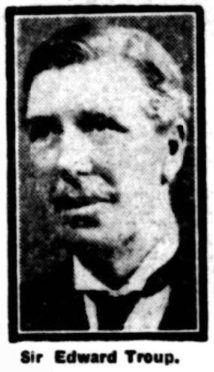
The Aberdeen Daily Journal reported: “In his tribute to the fallen, Sir Edward dwelt upon what the country had been saved from by the spirit of heroism and self-sacrifice.
“The memorial, which serves a decorative as well as a commemorative purpose, has been inserted in one of the windows of the secondary school.”
Addressing the crowd, Sir Edward said the window was erected “in order that those who came after them, in days when the story of the great war had become a tradition and a thing to be read of in books might know their names, might think of their great sacrifice, and if ever the call to fight for freedom should be sounded, be ready to respond to that call as they did.”
He added: “What was it that made those men the fine soldiers they were?
“They knew their fame. The 51st Highland Division was perhaps the finest in the British Army in France, and it was the most feared by the Germans.
“If they owed much to the national character and tradition, and much to their fighting forefathers, they would be the first to confess that they owed something also to their school.
“The Duke of Wellington was said to have declared that Waterloo was won in the playing fields of Eton. They might say The Gordon Schools and Castle Park helped to win the great war.”
He pondered that “the men whose names were inscribed on that window often sat in the trenches and in the rest camps let their hearts go back to the Castle Park where they played” and “to the schoolrooms where they worked”.
The ceremony ended with a prayer, the sounding of the Last Post and the singing of the National Anthem.
Memorial book
Sir Edward Troup hoped the names of the fallen would continue to be remembered by future generations.
Now, more than 100 years after the end of the war, the story of the memorial window and each of its 144 names has been researched and published in a 411-page book.
Valerie Ross, who teaches English at The Gordon Schools, was inspired to research the window after working with media studies pupils on a Poppy Scotland competition.
A memorial book was too ambitious a project for the competition, but an idea Valerie said “never went away”.
Valerie said: “The initial intention was to state the individual casualty’s name, date of birth and death, occupation and so on.
“But journals, the local archives, the Huntly Express, the Press and Journal, Evening Express and descendants revealed a trove of remarkable stories which I felt should be shared and commemorated, and so began five years of research.”
Carved Stone Painted Glass offers an insight into life in Huntly a century ago, a community still smarting from its wartime losses.
Using obituaries, letters and stories, it tells the story of the fate and bravery of each of the men involved.

No longer just names on a window, the research has brought the Huntly lads back to life.
Valerie said: “Pupils who attended university, or came from prominent local families were generally the easiest to research as their lives tended to be documented: accounts of achievements, prizes gained, tributes from friends and their alma mater’s Roll of Service.
“Tributes were also paid to those who had a trade or served an apprenticeship with a local business, weel kent faces like the postie and railway porter also warranted a mention.
“Less easy to find were the farm servants who moved around from place to place, leaving very little trace of themselves.”
Research revealed that some of the fallen were considered among the brightest minds of their generation such as the gifted scholar Frederick Rose, whose family received condolences from the King and Queen upon his death.
Valerie also included grieving families’ ‘in memoriam’ verses offering a humbling understanding of the true impact the war had on the people left behind.
She said: “The pride, sorrow, stoicism and absolute certainty in heavenly reunion expressed in these simple poems is heart-rending.”
During the war, families relied on newspapers and news reels to bring the reality of the frontline home.
Valerie added: “The words from the press of the day speak for themselves – they are an authentic window into those dark days of world war when horror and deprivation reached into every corner of the land.”
Future-proofing memorial window
Valerie’s work in highlighting the window also secured a grant of almost £1000 for repairwork in 2015.
Recognising its significance, the War Memorials Trust granted £940 for conservation work to replace dried out, cracked or missing putty.
Two missing pieces of glass were also replaced and the loose copper ties were slowly tightened to prevent breakages.
The whole window was also re-cemented on the external surface.
The book is available to purchase from Orbs community bookshop in Huntly, and to learn more or find information on stockists, visit: www.facebook.com/carvedstonepaintedglass
See more like this:
